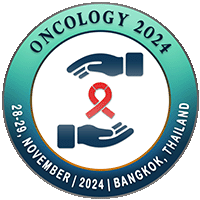
Henyk-Berezovska S. O
Institute of Hereditary Pathology National Academy of Medical Sciences of Ukraine, UkraineTitle: Predisposition risk assessment to radiation-associated thyroid cancer in persons with DNA repair genes XRCC1 and XPD polymorphism, exposed to ionizing radiation after Chernobyl disaster
Abstract
The aim of this work was to determine and compare the features of DNA repair gene XRCC1 Arg399Gln and XPD Lys751Gln polymorphisms in patients with thyroid cancer (TC), who were exposed to ionizing radiation (IR) as a result of the Chernobyl disaster, and in patients without exposure to ionizing radiation in history. Materials and methods. Determination of genes XRCC1 Arg399Gln and XPD Lys751Gln polymorphisms was performed by polymerase chain reaction (PCR) in 102 patients with thyroid cancer: 38 people, who were exposed to ionizing radiation due to Chernobyl disaster (members of the accident, and evacuees and residents from controlled areas contaminated with radionuclides), 64 individuals without exposure to ionizing radiation in history and 41 persons residents of Ukraine without cancer pathology in the control group. For comparison of the data on spontaneous and radiation-associated thyroid cancer and settlement of allele frequencies differences and risk of cancer pathology were used the literature data on control groups of populations of Russia, Belarus and Poland. Results. The frequency of chromosomal aberrations in peripheral blood lymphocytes in a group of patients with a history of radiation exposure (clean-up workers, evacuees and residents from areas contaminated with radionuclides) significantly exceeds that in healthy persons (4.02 ± 0.29 and 1.56 ± 0.23, respectively, p<0.001) and in the group of patients with spontaneous thyroid cancer (4.02 ± 0.29 and 2.76 ± 0.41, respectively, p <0.05). In peripheral blood lymphocytes of a group of patients with a history of radiation exposure, have been registered specific radiation markers (dicentricks), that are absent in patients with spontaneous thyroid cancer and in healthy persons of the control group.The obtained data testify to the inhibition of the ability of peripheral blood lymphocytes in patients with thyroid cancer to mitogen-induced blast transformation. Comparing to the literature data on XRCC1Arg399Gln polymorphisms in radiation-exposed individuals without cancer pathology, the risk of thyroid cancer in homozygous minor allele XRCC1 Gln399Gln carriers, who were exposed to ionizing radiation was significantly increased: OR = 4.14, p = 0.001 (CI95 % 1.7249.93). In homozygous carriers of the minor allele of the gene XPD Lys751Gln, exposed to IR, revealed increased risk of thyroid cancer: OR = 3.30, p = 0.05 (CI 95 % 0.82414.14), when compared with the control group of Ukrainian population. In the group of evacuees and residents from areas contaminated with radionuclides the highest level of chromosomal aberrations among all studied groups was registered and the association of XPD Lys751Gln and XRCC1 Arg399Gln genes polymorphisms with an increased level of spontaneous chromosomal aberrations in the culture of peripheral blood lymphocytes was revealed. The frequency of homozygous carriers of minor alleles of XPD and XRCC1 genes in patients with thyroid cancer with a history of radiation exposure was significantly higher than in patients with spontaneous TC. The carriage of homozygous minor allele of DNA repair genes XRCC1 Gln399Gln and XPD Gln751Gln is a risk factor for thyroid cancer under the influence of ionizing radiation in the study group of the Ukrainian population and may be the basis for forming a group of increased risk of predisposition to develop radiation-associated cancer pathology of the thyroid gland.
Biography
TBA!!!

